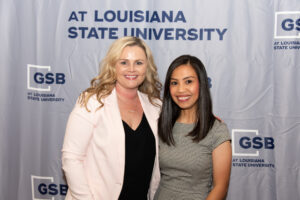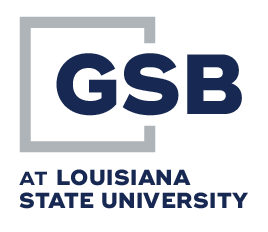5 Benefits of Enrolling in Graduate Banking School of LSU
/in Application, Community Banking, Graduate School Options, GSBLSU/by gsblsuIf you are reading this, you are likely weighing some important decisions. After all, attending a graduate school of banking is a big step in your career and education. You may have your pen ready with your list of pros and cons nearby as you look to this blog for some insight about why now is the time to attend. Fortunately, you’ve turned to a good source.
GSBLSU has a long history of helping its students gain a broader knowledge and understanding of major banking functions such as credits, investments, asset and liability management, planning and control, regulatory issues, human resources, and marketing. Here, we understand that instruction should take into account the changing context of the banking environment and seek to teach students through full participation to better prepare them. Over 16,800 graduates have been where you are now and have gone on to complete our program with great success.
We hope to include you in our upcoming session and help you make the best decision for your future. Here are five reasons why now is the time to attend Graduate School of Banking at LSU.
Take the Next Step in Your Banking Career
In many banking institutions, this program has become a prerequisite to advancement and success. To be successful, bank officers need the wisdom and expertise that comes from perception and insight—an astute ability to discover, discern, and decide. This is precisely the type of knowledge that GSBLSU has been offering for over 60 years.
A College Degree is Not Required to Enroll at GSBLSU
Students must have completed a college or American Institute of Banking credit for a course in basic accounting and for a course in either economics or money and banking. However, a degree is not required. Additional requirements include a minimum of three years of experience as an officer in the financial services industry or a minimum of five years of experience in bank supervision with a supervisory agency.
Excellent Networking Opportunities in the Banking Sector
The value of developing relationships and gaining knowledge from others within the banking industry is immeasurable. In past sessions, two-thirds of the student body at GSBLSU held the rank of vice president or higher, and the banks represented ranged in assets from under $100 million to over $200 billion.
You’ll receive the most current and effective teaching methods available
We are proud to have a faculty at GSBLSU that has extensive, expert knowledge of their subject areas. We strive to insure the most current and effective teaching methods with professors who are experienced bankers, academicians, regulatory officials, and attorneys. To further guarantee that our students receive the best professional education possible, all faculty and courses are critically evaluated on a regular basis.
M.B.A. Credit Available for Several Universities
Those completing the program at GSBLSU may enroll in professional MBA programs at several universities and receive graduate credit for their work at the banking school. These programs have no residence requirements and may be completed online. Universities currently participating include:
- Arkansas State
- Louisiana State University
- Mississippi College
- Mississippi State University
- Tennessee Tech University
- The University of Mississippi
- The University of South Carolina
- The University of Tennessee-Martin
- The University of West Georgia
- Union College of Kentucky
We understand the value and importance of this decision, and we hope that we’ve helped develop your list of pros. The Application deadline of April 15, 2024 is quickly approaching, and there truly is no time like the present to invest in your future. Simply click the button below to submit your application for the upcoming GSBLSU session and begin the next phase of a prosperous career. This is one decision that we promise you won’t regret.
How to Acquire and Retain Top Banking Professionals
/in Employee Retention, Graduate School Options, GSBLSU/by GSBLSU Effective leadership is crucial for any bank to succeed, and one of the critical factors that fall under the purview of such oversight is the acquisition and retention of top talent. Ensuring that the right employees are in the correct positions and have the right skill sets is necessary for organizational stability and future security.
Effective leadership is crucial for any bank to succeed, and one of the critical factors that fall under the purview of such oversight is the acquisition and retention of top talent. Ensuring that the right employees are in the correct positions and have the right skill sets is necessary for organizational stability and future security.
The Banking Management Simulation (BMSim): A Capstone Experience
/in GSBLSU, Leadership, News/by GSBLSUThe Banking Management Simulation (BMSim) is an immersive capstone experience that draws upon the knowledge and skills acquired throughout your time at the Graduate School of Banking at LSU (GSBLSU). This simulation places equal emphasis on risk management and financial performance, while also emphasizing the importance of teamwork, communication, and leadership for success.
Structure: The BMSim is structured around six communities of banks, with each community consisting of five to six banks. Within each community, there is an instructor and a regulator who oversee the operations. The course administrator is responsible for running the program and ensuring its smooth functioning.
Team Dynamics: Teams in the BMSim are comprised of 5-7 members, and the instructors do not assign the teams. It is common for team members to come from different banks and states, fostering a diverse and collaborative environment. Notably, one-time school administrators are permitted to select themselves as team members, further enhancing the interdisciplinary nature of the simulation.
Roles and Organization: In BMSim, teams have the autonomy to organize themselves and assign specific roles to members. Roles typically include lending, deposits, and investments. It is crucial for team members to discuss and decide on their roles prior to each session. Interestingly, it is encouraged for participants to volunteer for roles they do not typically handle in their real banks, promoting a broader understanding of various banking functions.
Key Role of the CEO: Perhaps the most important decision in the BMSim is the selection of the Chief Executive Officer (CEO). The CEO plays a vital role in determining the team’s success or failure. They are responsible for keeping everyone organized and focused while ensuring effective communication and avoiding conflicts. The CEO’s ability to delegate authority appropriately and employ the right management style, whether loose or committed, greatly impacts the team’s performance.
General Overview: At the start of the simulation, each bank holds a 10% market share. The market conditions, both on a national and community level, undergo constant changes. As the newly appointed management team, the previous management group has been dismissed, and the responsibility falls upon you to steer your bank to success. Each decision made represents a quarter in the simulation, which extends over eight quarters. It is important to consider the short and long-term implications of these decisions, as consistency in decision-making and performance is crucial. Furthermore, tradeoffs exist with every decision, necessitating careful consideration. Each community of banks competes independently of one another, emphasizing the significance of focusing on the big picture and not getting caught up in inconsequential issues.
Regulatory Structure: Regulators in the BMSim consist of current or retired regulators from State or Federal Agencies. These regulators are responsible for issuing new regulations and enforcing existing ones to ensure compliance within the simulation.
Regulations Used in BMSim: Within the BMSim, various regulations are implemented, such as “Federal Funds Purchased” and “Federal funds purchases in excess of 100% of owner’s equity.” These regulations primarily focus on liquidity management and the challenges associated with obtaining deposits.
The Banking Management Simulation (BMSim) offers a comprehensive and immersive capstone experience for participants at GSBLSU. As GSBLSU instructor David Coyle pointed out to students, by emphasizing risk management, financial performance, teamwork, communication, and leadership, the BMSim prepares future banking professionals for the challenges and complexities of the industry. Through the simulation’s structure, team dynamics, organization, and regulatory framework, participants gain a holistic understanding of the banking landscape, fostering critical thinking and decision-making skills that are vital for success in the real-world banking sector.
Faculty Spotlight: Dr. Mike Highfield
/in Faculty, GSBLSU, News/by GSBLSUFaculty Spotlight: Our own Dr. Mike Highfield (GSBLSU, VP for Curriculum) was recently published on the website, The Conversation, with his article regarding the history of the real estate mortgage – from its origins in Ancient Persia up to what we know it as today. In his article, Dr. Highfield also discusses the etymology of the word “mortgage” as well as its structural transformations over the years. I encourage you to visit the link below, as it is a great read and is written so it can be digested by the public (not an academic article).
GSBLSU Student Spotlight: Samuel James
/in GSBLSU, News, Student Spotlight/by gsblsu“LSU has a wonderful reputation for learning, not only inside the classroom but through networking opportunities with other bankers that can improve your knowledge,” remarks Samuel James, a student at the Graduate School of Banking at LSU and Senior Vice President of Enterprise Risk Management at Bank of Zachary. While James has worked in the financial industry for nearly a decade, he never balks at an opportunity to further his education and improve his performance as well as the services that he can offer his clients and financial institution.
Samuel’s day-to-day role has him overseeing compliance, BSA, CRA, CDFI officers, restricting terrorist financing, loan review, ALM, ALLL, and designing financial models. ”I build models, which is really just a fancy word for spreadsheets that perform stress tests. These tests help us determine liquidity and sensitivity for our clients,” says James. It is through his experience at GSBLSU that he is able to bring more knowledge and insight to his bank. “Bridging the knowledge between all aspects of the bank has been the greatest benefit of attending GSBLSU. Compliance, risk, capital, earnings, lending, asset quality, and employee retention, along with the case studies have provided exceptional understanding.”
Bank Regulatory Law class has really stood out in the curriculum for Sam. The Bank Regulatory Law course is designed to assist bankers in meeting the challenges of the rapidly changing regulatory environment. Topics include regulatory enforcement actions, mergers and acquisitions (including FDIC assisted deals), bank secrecy act, C.R.A., fair lending, bankruptcy, lender liability, and survival tactics for the new financial services industry. Attention is also given to current and proposed legislation as well as discussing the future of the financial services industry.
The interaction, networking opportunities, and lessons have become even more valuable to Samuel since the changes to work, school, and life that COVID created. This new way of working and connecting remotely has made James even more productive at home and at work. “Remote work has allowed me the ability to take care of family responsibilities while also tending to work needs such as an audit, exam, or an exit meeting.”
For those considering furthering their education and career in the banking industry, Samuel has words of wisdom, and furthermore, fond memories to share with prospective GSBLSU students. “Three years will pass whether you are in school or not; make those three years count.” As far as memories go, watching people from across the country experience some authentic south Louisiana charm never gets old. “Seeing people step out of their comfort zone and trying crawfish for the first time is always fun.”
GSB at LSU
4273 Highland Road
Baton Rouge, LA 70808
Phone: 225-766-8595
Resources
Other Programs
Louisiana State University MBA Program
Arkansas State MBA Program
Mississippi College MBA Program
Mississippi State University MBA Program
Murray State University MBA Program
Tennessee Tech University
Union Commonwealth University
University of Mississippi MBA Program
University of SC MBA Program
University of Tennessee at Martin
University of West Georgia MBA Program
